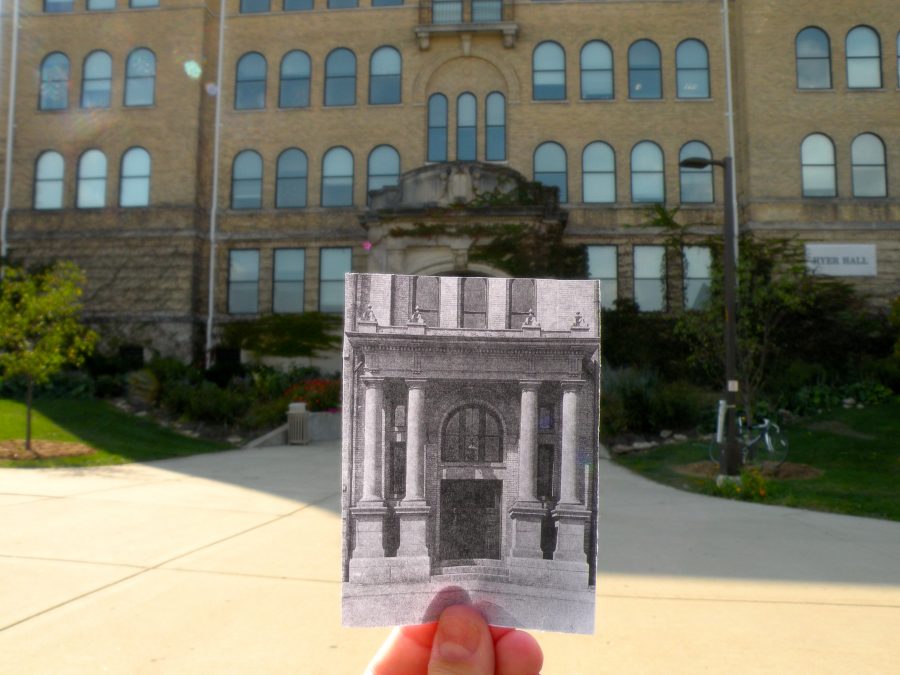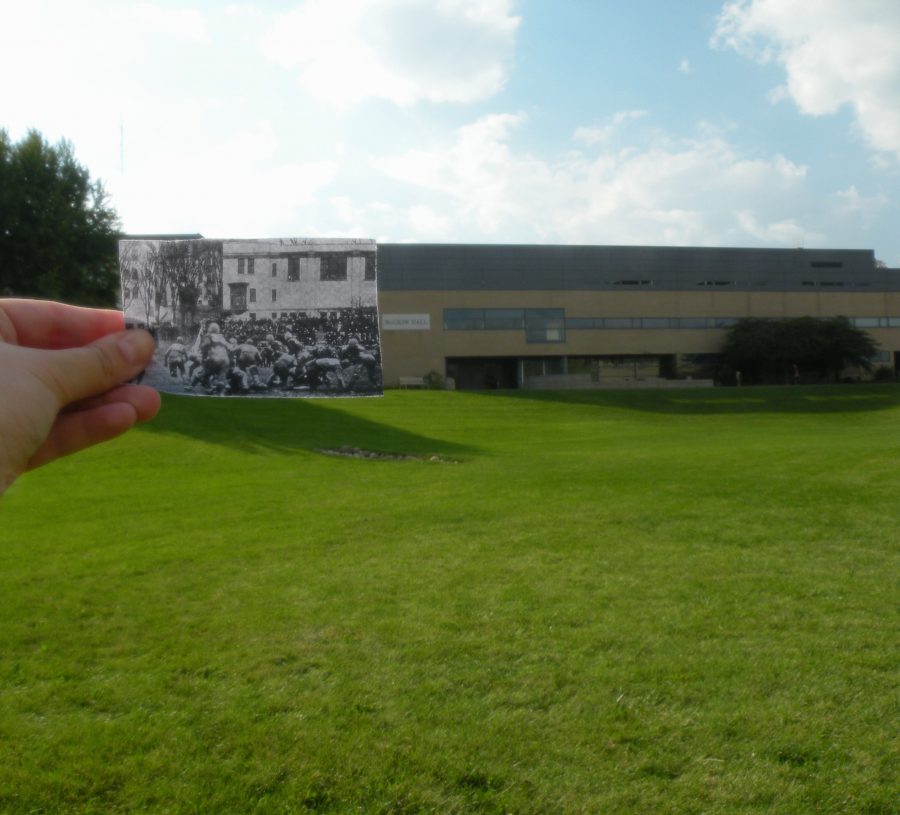Oct. 1, 2014
By Vesna Brajkovic
UW-Whitewater is ever-expanding with new construction plans popping up at every reach of campus. Each year, students encounter gradual changes as the student body expands and buildings, facilities and grounds become outdated. This historical campus, founded in 1868, has changed drastically over the years.
Fire at Old Main changes campus dynamic
An iconic part of the UW-W campus was the 102-year-old Old Main building that burned down 44 years ago on Feb. 7, 1970.
The only surviving wing of the building is now known as Hyer Hall, which was reopened in 1999 after major renovations.
Old Main was the heart of the campus at the time. It housed library materials, most of the classrooms, an auditorium and faculty offices.
The Old Main building is also one of the campus logos.
Losing Old Main had a big impact on campus, according to Andersen Library Service Assistant Charlene Klemp who has been on campus for 47 years.
“It was such a beautiful, beautiful entryway onto the campus,” Klemp said. “It was gorgeous, especially in the fall when the colors were out. [Losing the building] was hard.”
Changing geography of campus
It takes around 15 minutes to get from point A to point B anywhere on campus. But in the past, the campus was much more condensed. The Starin Road to Main Street quadrant held the majority of the campus.
The now green space in between Heide Hall, McGraw Hall and Andersen Library was once a football field and Hamilton Gymnasium.
The marching band would practice in the middle of campus and football spectators would huddle into the few seats available. It was minuscule compared to the current stadium, which can hold up to 11,000 people. Perkins Stadium opened in 1970, and was originally named Warhawk Stadium before being re-dedicated in 1996.
The Hamilton Gymnasium held the majority of physical education classes and had a swimming pool in the basement.
The only dining hall was centered in the University Center, known as the Student Union in the 1960s. The Esker and Drumlin Dining halls didn’t appear until later on.
Student life on campus in the 1960s
Klemp, a former student at Whitewater who used to live in McCutchan Hall, which is now a tutoring center, said the campus rules have changed a lot since she walked these sidewalks.
The original dorms, McCutchan, Baker and Salisbury halls, (and later Sayles Hall and White Hall) were strictly same-sex.
“Men were not allowed past a certain point – except for moving in and moving out,” Klemp said. “You had to sign in and out every time you left the dorm after a certain time. We had hours where you had to be in by 10:30 at night and you got two overnights allowed a semester.”
Later on, the six-pack, including Arey, Clem, Fricker, Lee, Bigelow and Benson Hall, and Wells Towers were also same-sex residence halls. The only co-ed dorm, according to a 1973-1974 campus map, was Fischer Hall.
The dress code was very strict for the residents in the ’60s.
Women were not allowed to wear pants or slacks to class. According to Klemp, unless the temperature was zero or below women had to wear dresses.
“The answer to the clothes questions is ‘Common Sense,’” read the 1962-66 University bulletin. “Pincurls and scarves are never allowed in the classrooms. Shorts and blue jeans are excluded from campus buildings at all times except for physical education purposes.”
Signing up for classes may seem daunting now, but in the 1960s it wasn’t just the click of a mouse; it was a two-day process. Students had to physically go to each department and take out a card. If something didn’t work out, you had to back track and exchange classes one-by-one.
Changes are more than just physical
Although the UW-W campus is full of history, there has been a lot of new expansion.
Klemp welcomed the change and said that the space is needed.
“Each campus needs to have its faculty together, you can’t have them spread out over campus the way it’s been previously,” Klemp said on the new office building, Laurentide.
Klemp said that one of the biggest positive impacts on campus has been the leadership.
“I think right now, in all the years that I’ve been here, it has been good that Chancellor Telfer and the provost’s office do not just sit behind their desks,” Klemp said. “They really mingle and really seem to care what [others] think, and how they think, and are willing to put themselves out there. I didn’t see that with some of the other chancellors. I think that’s gone a long way to helping improve the over all feel of the campus. That we are a family.”




Cheryl A. Koski • Jun 1, 2017 at 5:55 pm
Who is Charlene Klemp and why is she allowed to be the only source for this article about subjects that I know much better than she does, including Sayles Hall?
I lived in Sayles Hall, Room 426, from the day that I arrived at UW-Whitewater in the fall of 1975 until the day that I graduated in the spring of 1979.
“You got two overnights allowed per semester,” Klemp says of the all-female dorm, Sayles Hall. Two overnights for what??? For men to stay in your room??? I don’t think so! Almost all of us had female roommates, and I never knew a man to stay overnight in Sayles Hall. Maybe it happened against the rules, but as for “two overnights allowed per semester”??? Absolutely not!!!
In the future, you need to source your stories more carefully with more than one individual providing her own skewed memories of UW-Whitewater.
As for Klemp’s statement that Chancellor Tefler is the only decent chancellor in the history of UW-W, come on. He and he alone made UW-Whitewater recently feel like a family? Not true.
He was decades away from becoming chancellor when I was a student at UW-W, and though he’s a nice guy (I’ve met him), UW-W felt like a family during the mid- to late-70s when I was a student at Sayles Hall, which was centrally located both to my classes and Drumlin Hall (where I ate three meals per day).
Now Sayles Hall and White Hall are gone, and students today are relegated to dorms that are far from the central part of the campus.
I realize that “my Whitewater,” the wonderful place that I remember, is gone forever, and that it exists now only in my memory.
When the Royal Purple writes articles about the history of UW-Whitewater, it should show some respect for the past and how, in my opinion, the past exceeded the present in just about every way imaginable (tuition was $350/semester when I was a student–now, doesn’t that make current students salivate?).
Sincerely,
Cheryl A. Koski, Ph.D.
MZ • Apr 25, 2017 at 1:53 pm
Good try, but that photo you’re holding is the entrance to Old Main, not the East Wing. The East Wing Entrance looks nearly identical to how it originally looked.
Cheryl A. Koski • Jun 9, 2017 at 9:50 am
Yes–where are Woodward and Goldstein when you really need them? STUDENTS: please fact check your stories thoroughly with MANY sources, not just one.